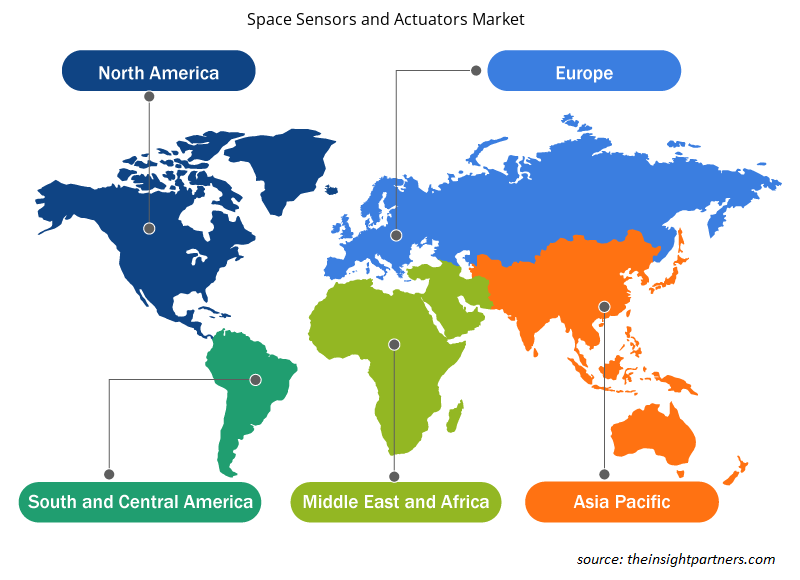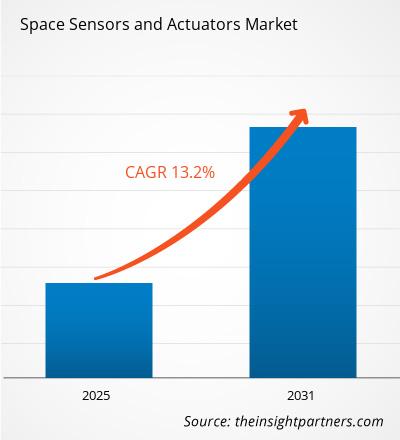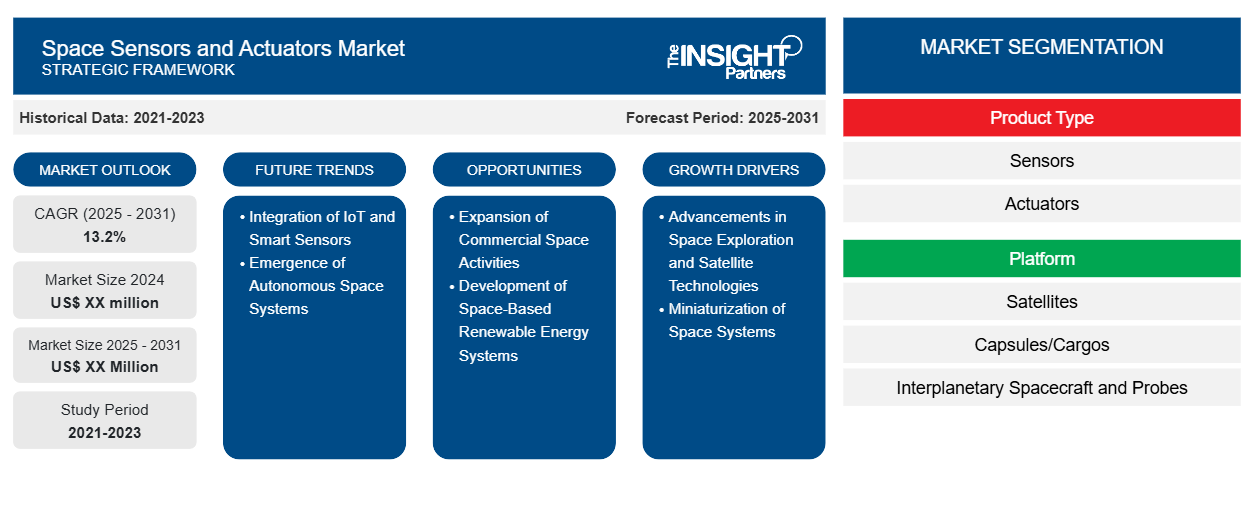من المتوقع أن يسجل سوق أجهزة الاستشعار والمحركات الفضائية معدل نمو سنوي مركب بنسبة 13.2٪ من عام 2023 إلى عام 2031، مع توسع حجم السوق من XX مليون دولار أمريكي في عام 2023 إلى XX مليون دولار أمريكي بحلول عام 2031.
تم تقسيم التقرير حسب نوع المنتج (أجهزة الاستشعار، المحركات). كما يقدم التقرير تحليلاً يعتمد على المنصة (الأقمار الصناعية، الكبسولات/الحمولات، المركبات الفضائية بين الكواكب والمسبارات، المركبات الجوالة/مركبات الهبوط الفضائية، مركبة الإطلاق). كما يقدم التقرير تحليلاً يعتمد على المستخدم النهائي (التجاري والحكومي والدفاعي). كما تم تقسيم التحليل العالمي على المستوى الإقليمي والدول الرئيسية. يقدم التقرير القيمة بالدولار الأمريكي للتحليل والقطاعات المذكورة أعلاه.
غرض التقرير
يهدف تقرير سوق أجهزة الاستشعار والمحركات الفضائية الصادر عن The Insight Partners إلى وصف المشهد الحالي والنمو المستقبلي وأهم العوامل الدافعة والتحديات والفرص. وسيوفر هذا رؤى لمختلف أصحاب المصلحة في الأعمال التجارية، مثل:
- مزودي/مصنعي التكنولوجيا: لفهم ديناميكيات السوق المتطورة ومعرفة فرص النمو المحتملة، وتمكينهم من اتخاذ قرارات استراتيجية مستنيرة.
- المستثمرون: إجراء تحليل شامل للاتجاهات فيما يتعلق بمعدل نمو السوق، وتوقعات السوق المالية، والفرص المتاحة عبر سلسلة القيمة.
- الهيئات التنظيمية: لتنظيم السياسات ومراقبة الأنشطة في السوق بهدف تقليل الانتهاكات والحفاظ على ثقة المستثمرين والحفاظ على سلامة السوق واستقرارها.
تجزئة سوق أجهزة الاستشعار والمحركات الفضائية
نوع المنتج
- أجهزة الاستشعار
- المحركات
منصة
- الأقمار الصناعية
- كبسولات/شحنات
- المركبات الفضائية والمسبارات بين الكواكب
- المركبات الفضائية/مركبات الهبوط
- مركبة الإطلاق
المستخدم النهائي
- تجاري
- الحكومة والدفاع
الجغرافيا
- أمريكا الشمالية
- أوروبا
- آسيا والمحيط الهادئ
- أمريكا الجنوبية والوسطى
- الشرق الأوسط وأفريقيا
الجغرافيا
- أمريكا الشمالية
- أوروبا
- آسيا والمحيط الهادئ
- أمريكا الجنوبية والوسطى
- الشرق الأوسط وأفريقيا
قم بتخصيص هذا التقرير ليناسب متطلباتك
ستحصل على تخصيص لأي تقرير - مجانًا - بما في ذلك أجزاء من هذا التقرير، أو تحليل على مستوى الدولة، وحزمة بيانات Excel، بالإضافة إلى الاستفادة من العروض والخصومات الرائعة للشركات الناشئة والجامعات
- احصل على أهم اتجاهات السوق الرئيسية لهذا التقرير.ستتضمن هذه العينة المجانية تحليلاً للبيانات، بدءًا من اتجاهات السوق وحتى التقديرات والتوقعات.
محركات نمو سوق أجهزة الاستشعار والمحركات الفضائية
- التطورات في استكشاف الفضاء وتقنيات الأقمار الصناعية: إن التوسع في استكشاف الفضاء، بما في ذلك البعثات إلى القمر والمريخ وما بعدهما، يدفع الطلب على أجهزة الاستشعار والمحركات المتقدمة. وتعتبر هذه التقنيات بالغة الأهمية لجمع البيانات والتحكم في المركبات الفضائية وإدارة الحمولات في بيئات الفضاء العميق. ومع زيادة وكالات الفضاء والشركات الخاصة للاستثمار في الاستكشاف، أصبحت أجهزة الاستشعار والمحركات مكونات أساسية، مما يدفع نمو السوق لتلبية الاحتياجات المتنوعة للبعثات الفضائية المستقبلية.
- تصغير أنظمة الفضاء: إن الاتجاه المتزايد نحو الأقمار الصناعية الأصغر حجمًا والأكثر كفاءة، مثل الأقمار الصناعية المكعبة والأقمار الصناعية الصغيرة، هو المحرك الرئيسي لسوق أجهزة الاستشعار والمحركات الفضائية. تتطلب هذه الأنظمة المصغرة أجهزة استشعار ومحركات مدمجة وخفيفة الوزن يمكنها العمل بشكل موثوق في ظروف الفضاء القاسية. ومع انتشار مجموعات الأقمار الصناعية والمهام الفضائية الصغيرة الحجم، يتسارع الطلب على أجهزة الاستشعار والمحركات المصغرة عالية الأداء، مما يدفع الابتكار ونمو السوق.
الاتجاهات المستقبلية لسوق أجهزة الاستشعار والمحركات الفضائية
- دمج إنترنت الأشياء والمستشعرات الذكية: إن دمج تقنيات إنترنت الأشياء والمستشعرات الذكية في أنظمة الفضاء هو اتجاه متنامٍ. يمكن لهذه المستشعرات توفير بيانات في الوقت الفعلي عن صحة المركبة الفضائية والظروف البيئية ومقاييس الأداء. يتم اعتماد المستشعرات التي تدعم إنترنت الأشياء، والتي توفر المراقبة عن بعد وتحليل البيانات، بشكل متزايد في المهام الفضائية للتشغيل الفعال واكتشاف الأعطال. هذا الاتجاه يحفز الطلب على أجهزة استشعار ومحركات فضائية متقدمة قادرة على اتخاذ القرارات الذكية والتكامل السلس في الأنظمة المعقدة.
- ظهور أنظمة الفضاء المستقلة: مع تزايد استقلالية أنظمة الفضاء، هناك طلب متزايد على أجهزة استشعار ومحركات متقدمة يمكنها تمكين المراقبة في الوقت الفعلي واتخاذ القرار والتحكم دون تدخل بشري. تتطلب المركبات الفضائية والمركبات الجوالة والأقمار الصناعية المستقلة أجهزة استشعار ومحركات دقيقة وموثوقة للعمل في بيئات بعيدة وغير متوقعة. إن التحول نحو الاستقلالية في أنظمة الفضاء يدفع إلى تطوير وتكامل تقنيات أجهزة الاستشعار والمحركات المتقدمة التي تعد ضرورية لتمكين هذه القدرات، وتعزيز النمو في السوق.
فرص سوق أجهزة الاستشعار والمحركات الفضائية
- التوسع في الأنشطة الفضائية التجارية: إن تسويق الفضاء، بما في ذلك الاتصالات عبر الأقمار الصناعية، ومراقبة الأرض، والسياحة الفضائية، يفتح فرصًا جديدة لأجهزة الاستشعار والمحركات الفضائية. وتحتاج الشركات الخاصة، مثل سبيس إكس وبلو أوريجين وغيرهما، إلى أنظمة استشعار وتحكم متقدمة لمجموعات الأقمار الصناعية ومركبات الإطلاق والموائل الفضائية. ومع استمرار توسع هذه الأنشطة التجارية، سيزداد الطلب على أجهزة الاستشعار والمحركات الفضائية الموثوقة وعالية الأداء، مما يخلق طرق نمو جديدة للسوق.
- تطوير أنظمة الطاقة المتجددة الفضائية: إن الاهتمام المتزايد بالطاقة الشمسية الفضائية وغيرها من حلول الطاقة المتجددة يخلق فرصة كبيرة لأجهزة الاستشعار والمحركات الفضائية. تتطلب هذه الأنظمة أجهزة استشعار متقدمة لمراقبة الظروف البيئية وأجهزة تشغيل لضبط مجموعات الألواح الشمسية وأنظمة نقل الطاقة. ومع اكتساب مشاريع الطاقة المتجددة الفضائية زخمًا، سترتفع الحاجة إلى أجهزة استشعار ومحركات دقيقة وفعالة يمكنها العمل في الفضاء، مما يوفر سوقًا ناشئة لهذه التقنيات.
رؤى إقليمية حول سوق أجهزة الاستشعار والمحركات الفضائية
لقد قام المحللون في Insight Partners بشرح الاتجاهات والعوامل الإقليمية المؤثرة على سوق أجهزة الاستشعار والمحركات الفضائية طوال فترة التوقعات بشكل شامل. يناقش هذا القسم أيضًا قطاعات سوق أجهزة الاستشعار والمحركات الفضائية والجغرافيا في جميع أنحاء أمريكا الشمالية وأوروبا ومنطقة آسيا والمحيط الهادئ والشرق الأوسط وأفريقيا وأمريكا الجنوبية والوسطى.

- احصل على البيانات الإقليمية المحددة لسوق أجهزة الاستشعار والمحركات الفضائية
نطاق تقرير سوق أجهزة الاستشعار والمحركات الفضائية
| سمة التقرير | تفاصيل |
|---|---|
| حجم السوق في عام 2023 | XX مليون دولار أمريكي |
| حجم السوق بحلول عام 2031 | XX مليون دولار أمريكي |
| معدل النمو السنوي المركب العالمي (2023 - 2031) | 13.2% |
| البيانات التاريخية | 2021-2022 |
| فترة التنبؤ | 2024-2031 |
| القطاعات المغطاة | حسب نوع المنتج
|
| المناطق والدول المغطاة | أمريكا الشمالية
|
| قادة السوق وملفات تعريف الشركات الرئيسية |
|
كثافة اللاعبين في سوق أجهزة الاستشعار والمحركات الفضائية: فهم تأثيرها على ديناميكيات الأعمال
يشهد سوق أجهزة الاستشعار والمحركات الفضائية نموًا سريعًا، مدفوعًا بالطلب المتزايد من المستخدم النهائي بسبب عوامل مثل تفضيلات المستهلكين المتطورة والتقدم التكنولوجي والوعي المتزايد بفوائد المنتج. ومع ارتفاع الطلب، تعمل الشركات على توسيع عروضها والابتكار لتلبية احتياجات المستهلكين والاستفادة من الاتجاهات الناشئة، مما يؤدي إلى زيادة نمو السوق.
تشير كثافة اللاعبين في السوق إلى توزيع الشركات أو المؤسسات العاملة في سوق أو صناعة معينة. وهي تشير إلى عدد المنافسين (اللاعبين في السوق) الموجودين في مساحة سوق معينة نسبة إلى حجمها أو قيمتها السوقية الإجمالية.
الشركات الرئيسية العاملة في سوق أجهزة الاستشعار والمحركات الفضائية هي:
- شركة تكساس إنسترومنتس
- شركة هونيويل الدولية
- شركة موغ
- شركة تيليداين المحدودة في المملكة المتحدة
- شركة أميتيك
إخلاء المسؤولية : الشركات المذكورة أعلاه ليست مرتبة بأي ترتيب معين.

- احصل على نظرة عامة على أهم اللاعبين الرئيسيين في سوق أجهزة استشعار الفضاء والمحركات
نقاط البيع الرئيسية
- التغطية الشاملة: يغطي التقرير بشكل شامل تحليل المنتجات والخدمات والأنواع والمستخدمين النهائيين لسوق أجهزة الاستشعار والمحركات الفضائية، مما يوفر صورة شاملة.
- تحليل الخبراء: تم تجميع التقرير على أساس الفهم العميق لخبراء الصناعة والمحللين.
- معلومات محدثة: يضمن التقرير أهمية الأعمال التجارية بسبب تغطيته للمعلومات الحديثة واتجاهات البيانات.
- خيارات التخصيص: يمكن تخصيص هذا التقرير لتلبية متطلبات العملاء المحددة وبما يتناسب مع استراتيجيات العمل بشكل مناسب.
وبالتالي، يمكن أن يساعد تقرير البحث حول سوق أجهزة الاستشعار والمحركات الفضائية في تمهيد الطريق لفك شفرة وفهم سيناريو الصناعة وآفاق النمو. ورغم وجود بعض المخاوف المشروعة، فإن الفوائد الإجمالية لهذا التقرير تميل إلى التفوق على العيوب.
- التحليل التاريخي (سنتان)، سنة الأساس، التوقعات (7 سنوات) مع معدل النمو السنوي المركب
- تحليل PEST و SWOT
- حجم السوق والقيمة / الحجم - عالمي، إقليمي، بلد
- الصناعة والمنافسة
- مجموعة بيانات إكسل
التقارير الحديثة
تقارير ذات صلة
شهادات العملاء
سبب الشراء
- اتخاذ قرارات مدروسة
- فهم ديناميكيات السوق
- تحليل المنافسة
- رؤى العملاء
- توقعات السوق
- تخفيف المخاطر
- التخطيط الاستراتيجي
- مبررات الاستثمار
- تحديد الأسواق الناشئة
- تحسين استراتيجيات التسويق
- تعزيز الكفاءة التشغيلية
- مواكبة التوجهات التنظيمية





















 احصل على عينة مجانية ل - سوق أجهزة الاستشعار والمحركات الفضائية
احصل على عينة مجانية ل - سوق أجهزة الاستشعار والمحركات الفضائية